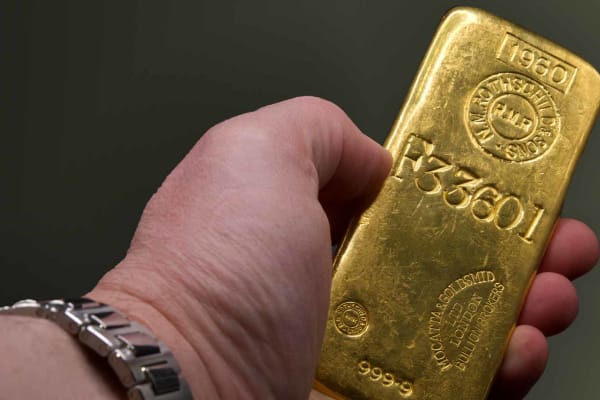
How much is gold worth?
Gold in an internationally traded commodity and the price varies on a daily basis.

Gold has fascinated people for centuries, not just for its stunning beauty but also for its substantial value. Have you ever wondered how much one ton of this precious metal is actually worth? The answer might surprise you - it's not just a few shiny coins or elegant jewellery pieces; we're talking about tens of millions of UK pounds! In this article, we'll break down the current market value of gold, explore how it's measured, and look at the reasons behind its high price. Whether you're an aspiring investor or just curious about this glittering asset, there's much to unravel about gold's role in today's economy.
As of 16th November 2025, one metric ton of gold is valued at £99,577,259.27 GBP, based on a current spot price of £3,097.20 per troy ounce. This immense value underscores the significant investment potential and status of gold as a valuable commodity globally.
Ever wondered what your body weight is worth in gold? Our Gold Weight Calculator lets you find out in seconds. Simply enter your weight in stone, pounds, or kilograms, and see how much you'd be worth if you were made entirely of pure 24ct gold. It's a fun (and surprisingly eye-opening) way to put gold prices into perspective.
The foundation of gold measurement revolves around a few key metrics that help buyers and investors properly gauge its value.
At the heart of gold measurement lies the troy ounce, which is the standard unit used for precious metals. Unlike regular (imperial) ounces found in cooking, one troy ounce weighs approximately 31.1 grams, as opposed to 28 grams. This specific unit has historical roots in the Roman monetary system and remains the benchmark today.
When we discuss a metric ton of gold, we mean a considerable amount - about 32,150.7 troy ounces make up one metric ton.
Another important concept is carat, which defines gold's purity level. Pure gold rates at 24 carats, meaning it consists of 100% gold with no other alloys mixed in. However, because pure gold is relatively soft and malleable, it's common for jewellers to alloy it with other metals for added strength and durability. When you see jewellery marked as 18ct or 9ct, for instance, that indicates the proportion of pure gold within the alloy - 18ct signifies 75% gold, while 9ct represents 37.5%.
In practical terms, whether you're buying jewellery or investing in bullion, understanding these measurements can help you make informed decisions.
With a firm grasp on these basics of gold measurement, we can now transition into examining the elements that influence gold's market value and the intricacies behind its pricing dynamics.
The market value of gold, particularly when measured by tonnage, serves as a barometer not just for this precious metal but for economic stability as a whole. As of 16th November 2025, the price of gold sits at £3,097.20 per ounce. This means that one metric ton of gold would be valued at £99,577,259.27. While this figure showcases the worth of gold in a tangible sense, it also reflects larger economic trends and consumer behaviours.
Recent data highlights significant price movements over the last few years, as shown in the table below:
| Year | Price per Ton (£ million GBP) |
|---|---|
| 2024 | 61 |
| 2023 | 51 |
| 2022 | 49 |
Investors often turn to gold during times of uncertainty; its historical performance suggests resilience against inflationary pressures. Investing in gold can act as a hedge against volatility in other markets, such as stocks or real estate. For those looking to diversify their portfolios amidst ongoing economic fluctuations, like high inflation rates, gold remains a popular choice.
Notably, while physical possession of gold through bars or coins is traditional, many individuals find solace in more liquid forms such as ETFs.
Exchange-traded funds (ETFs) allow for easy access to gold exposure without the logistical concerns associated with storing physical gold. This modern method appeals to a broad audience, from first-time investors seeking safety to seasoned traders looking for strategic opportunities. Consequently, as demand for gold fluctuates with market sentiment, it drives home the importance of staying informed about current pricing and investing options.
With this understanding of current market values and trends, let's consider how various factors affect these prices, shaping investment strategies and decisions along the way.
Various elements converge to affect the market value of gold, and each holds significance in the grand scheme of economics. Foremost among these is the relationship between supply and demand. When demand spikes due to geopolitical uncertainties or economic crises, or when supply diminishes due to mining disruptions, you can typically expect prices to rise. However, one should acknowledge that this dance between supply and demand is influenced by an array of other factors.
During times of turmoil, be it a financial crisis, trade disputes, or political unrest, investors often gravitate toward gold as a symbol of stability. This instinct comes from gold's historical role as a safe-haven asset. For instance, during significant downturns in the market or when global tensions rise, people choose gold over more volatile assets like stocks or real estate. According to various economic analysts, central banks in countries like Russia and China have bolstered their gold reserves as a hedge against uncertainty associated with US dollar fluctuations.
Such movements illustrate how investor sentiment can cause ripples throughout the market, prompting broader discussions about inflation and currency values.
Inflation is another key driver of gold prices. In environments where fiat currency appears to lose its purchasing power, often mirrored in rising consumer prices, investors look to gold as a protective measure. Gold has historically maintained its value better than many currencies during inflationary periods. As a result, when inflation rates rise, so does the allure of owning gold, leading to higher demand and consequently higher prices.
Now, consider how external pressures such as currency values also shape the landscape for gold pricing.
The strength of currencies, particularly the US dollar (USD), plays a vital role in determining gold prices. A weaker USD typically results in elevated gold prices because commodities like gold are priced in dollars; thus, international buyers find it less costly when the dollar weakens. Conversely, when the dollar strengthens against other currencies, it can lead to a dip in demand for gold since it becomes more expensive for foreign investors.
If you're tracking trends in gold prices, pay attention to currency valuations alongside emerging economic indicators. Keeping an eye on geopolitical developments can give you plenty of insights into potential shifts in demand for this precious metal.
As you navigate through fluctuations in the gold market and consider all these influencing factors - economic uncertainty, inflation rates, and currency values - consider how they intertwine and impact the overall worth of gold.
With these insights into market dynamics at play, we now shift our focus to understanding how to quantify this valuable commodity by its weight.
Determining the value of a specific weight of gold is quite straightforward.
The first step is crucial: determine the weight in ounces. Gold is sold in troy ounces, a traditional unit of measure still widely used today. Specifically, a metric ton equals 32,150.7 troy ounces, and this critical conversion sets the stage for your valuation.
Next, you'll need to know the current spot price for gold. This price fluctuates based on market conditions, with reputable financial news websites and commodities exchanges providing daily pricing updates. Imagine scanning through your favourite finance app or website, the numbers changing like a live auction, reflecting the current valuation of gold - the more you understand this dynamic pricing, the better equipped you'll be as either an investor or a curious enthusiast.
After you have both the number of ounces and the spot price, it’s time for the fun part—calculating the total value. To achieve this, simply multiply the number of troy ounces by the spot price per ounce.
For instance, if today's spot price is £3,097.20 per troy ounce, then by applying the calculation to one metric ton of gold:
£3,097.20 (spot price) * 32,150.7 (troy ounces) equals approximately £99,577,259.27.
As we transition from valuation methods to understanding its broader implications, recognising gold's diverse roles in financial systems offers valuable insights into why it remains a coveted asset.
Gold plays multiple vital roles within the financial sector, acting not just as a commodity but also as an integral part of economic stability. One of its primary functions is serving as a hedge against inflation and currency fluctuations. When the value of paper money becomes uncertain, investors often turn to gold because it tends to retain its intrinsic value. Throughout history, during times of turmoil, from wars to economic crises, gold has demonstrated its resilience, maintaining its status as a safe haven. This entrenched reliability makes it an attractive option for investors looking to safeguard their assets.
Particularly noteworthy is how central banks around the world leverage gold to support their currencies. By holding significant reserves, they create a buffer against economic downturns and provide a sense of stability within the financial system. For instance, the United States currently possesses approximately 8,133.5 metric tons of gold. This staggering amount underscores the confidence placed in gold as a secure asset.
Central banks utilise gold not solely for monetary policy but also because it serves as a reliable store of value that can be tapped into during financial crises.
Additionally, another important avenue for investors is through Gold-backed Exchange-Traded Funds (ETFs). These investment vehicles offer liquidity and ease of access while simultaneously pairing the security associated with owning physical gold. Unlike direct purchases, where storage can become an issue or require additional costs, ETFs allow individuals to invest in gold without worrying about transport and protection, making gold investments more accessible to everyday traders and institutional investors alike.
Storing gold securely is equally important, given its immense value; whether you hold it physically or through ETFs, ensuring its safety remains paramount for anyone engaged in gold investment. This leads us to consider the best ways to keep your investment secure and protected from potential risks.
Storing gold effectively requires attention to security and accessibility, as these factors can significantly impact the value of your investment over time. There are several avenues one might consider when safeguarding such a prized asset.
One common option is utilising safe deposit boxes at banks. These secure facilities are designed specifically for protecting valuable items, including gold. While the high level of security they offer is unparalleled, it comes with limitations - namely, restricted access. Often, individuals must visit the bank during business hours, which may not be convenient in emergencies. Furthermore, you may not have immediate access to your gold if you need quick liquidity, and additional fees may apply annually. Keeping this balance between accessibility and security is essential for any investor.
Alternatively, investing in a high-quality home safe is another effective storage method. This provides easier access compared to a bank while still delivering a decent level of protection. To maximise safety, your safe should be well-hidden - in a location where it wouldn't attract attention - and built to be resistant to both theft and fire. When selecting a safe, consider one with a reliable locking mechanism and ample weight to deter potential thieves. Always choose an appropriate Eurograde rated safe that exceeds the value of its contents. The higher the Eurograde rating, the more robust the security.
However, while home safes empower you with readiness to trade when needed, it's crucial to recognise the risks involved in having valuable assets stored within your living space. Insurance considerations should also be taken into account; many homeowners' policies may be insufficient to cover the value of gold stored at home.
For those seeking more extensive protection, allocated storage in professional vaults is worth considering. In this setup, the gold is secured in a facility that provides extensive insurance coverage. Unlike generic vault storage, where your gold is pooled with other clients', allocated storage ensures that your exact pieces are kept separate for you alone. This arrangement eliminates concerns over theft or damage while providing peace of mind about ownership verification.
Regardless of your choice of storage method, it's important to weigh personal convenience against security needs before making a decision. Your unique circumstances will dictate whether the flexibility of keeping gold at home outweighs the superior safeguards offered by banks or vaults.
Beyond its allure as a precious metal for jewellery or investment, gold proves to be indispensable across multiple industries. It's fascinating to see how this shiny element integrates itself into vital sectors, serving purposes far beyond what most people immediately recognise.
In electronics, gold's superiority shines through. Its exceptional conductivity makes it an ideal material for high-quality connectors and components that ensure efficient performance. In smartphones, laptops, and other electronic devices, tiny gold contacts facilitate seamless communication within their circuits.
While many may not consider the iconic gold-colored connectors inside their devices, they are the silent workhorses ensuring functionality. Notably, over 10% of global gold demand comes from this sector alone, illustrating its key role in driving technological advancements.
Shifting gears to medicine, gold plays a pivotal role as well. The use of gold nanoparticles has emerged as a revolutionary approach in targeted cancer treatments. These minuscule particles can be engineered to attach to specific cells, allowing for precise delivery of therapy while reducing damage to surrounding healthy tissue.
But that's not all—gold's inert properties make it exceptionally useful in dental work and medical implants, where durability and biocompatibility are paramount. Imagine having a dental crown or implant that doesn't corrode or cause allergic reactions—a game changer in healthcare.
Moreover, when we look at the stars and space exploration, gold again finds a noteworthy application. Gold's reflective properties serve a crucial purpose by protecting spacecraft from solar radiation. For instance, many satellites are coated with a thin layer of gold to shield sensitive equipment from the harmful effects of cosmic rays and heat from the sun. This protective quality ensures that missions remain successful and our explorations continue unhindered.
Therefore, the multifaceted uses of gold in electronics, medicine, and even space exploration enhance its enduring value around the globe. As we explore how integral this precious metal is in various fields, it becomes evident that gold's worth extends far beyond its price tag - it embodies a crucial resource in advancing technology and improving lives everywhere.
By understanding these practical applications, we gain insights into why gold remains a cornerstone in modern industry - its value is rooted not only in aesthetics but in its vast contributions to daily life and technological progress.
The price of gold is influenced by several key factors, including supply and demand dynamics, inflation rates, currency strength (particularly the US dollar), and geopolitical stability. For instance, during times of economic uncertainty or political unrest, demand for gold often increases as investors seek safe-haven assets, driving prices up. Additionally, central bank policies regarding interest rates can affect how attractive gold becomes compared to interest-yielding assets. According to data from 2023, the price of gold fluctuated significantly based on these variables, showcasing its role as a hedge against inflation and economic instability.
Over the last decade, the value of gold has seen significant fluctuations, generally trending upwards with notable peaks during economic uncertainty. In 2015, the price was around £750 per ounce, and by 2023, it had surged to approximately £1,600 per ounce. Factors influencing this rise include global economic instability, inflation fears, and increased demand from central banks and investors seeking safe-haven assets during volatile times.
Yes, historical events have significantly impacted gold prices. For instance, during the 2008 financial crisis, gold prices surged as investors flocked to safe-haven assets, reaching around £550 per ounce by the end of that year. Similarly, geopolitical tensions and currency fluctuations can cause spikes in gold prices; for example, in 2020 amidst the COVID-19 pandemic, gold hit an all-time high of just over £1,570 per ounce as uncertainty prevailed. These events illustrate how external pressures and global events can lead to substantial volatility in gold markets.
Gold can be purchased in several forms, including bullion bars, coins, jewellery, and exchange-traded funds (ETFs). Bullion bars are typically the most cost-effective way to buy gold per ounce due to lower premiums over spot prices, while gold coins such as American Eagles and Canadian Maple Leafs may carry higher premiums due to their numismatic value and minting costs. ETFs allow investors to buy gold shares without holding physical gold, making them a convenient option but often with management fees that can impact returns. As of October 2023, the price of gold fluctuated around £1,600 per ounce, with coins sometimes costing 5-20% more than bullion bars due to their collectable nature.

Gold in an internationally traded commodity and the price varies on a daily basis.

Many cultures have been lured by the beauty and power that gold represents.

The stock market crash of 1929 was one of the most devastating events in American history, directly bringing about the Great Depression.